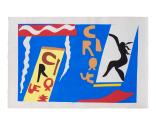Jazz
Artist: Henri Matisse (French, 1869-1954)
Author: Henri Matisse (French, 1869-1954)
Publisher: Tériade, Paris
Date: 1947
Dimensions:
Portfolio: H: 26 1/4 in. (667 mm); W: 17 1/2 in. (444 mm); Depth: 3/4 in. (19 mm).
Leaf (untrimmed): H: 25 1/2 in. (648 mm); W: 16 5/8 in. (422 mm).
Medium: Reproduction: line block reproduction of brush sketches of the pochoir prints and handwritten titles (key to the plates).
Text: letterpress (typeface: Deberny & Peignot Garamont capitals).
Paper: Arches cream wove.
Classification: Prints
Credit Line: Gift of Molly and Walter Bareiss
Object number: 1985.85A-V
Label Text:
When Henri Matisse took up a proposal to make an album in color, he was seriously ill following cancer surgery and deeply disturbed by European events. Nevertheless, in 1943-44, working in vividly-hued cut paper, he created twenty collages from which the stenciled prints were made. Initially entitled The Circus, these images, as Matisse wrote, "have resulted from the crystallizations of memories of the circus, popular tales, or of travel." Here, he depicted the Codomas brothers, celebrated trapezists of decades before, executing their dangerous maneuvers above the net.
In his text for Jazz, Matisse described his technique as "Drawing with scissors: Cutting directly into color." Late in life, he found new ways to resolve what he called "the eternal conflict of drawing and color." The subject here is a female swimmer watched by a red-faced man, a spectacle he recalled from a Parisian music hall. Like The Codomas nearby, Matisse's image parallels his accompanying text musing on airplane travel, on "the perception of limitless space in which for a moment we felt so free."
Henri Matisse, Jazz (1947)
“Drawing with scissors—cutting directly into vivid color reminds me of the direct carving of the sculptor on stone. My book has emerged from this spirit.” (Henri Matisse, Jazz)
Henri Matisse first cut shapes in color paper in 1931–33 to create the design layout of his mural The Dance. It was a method he would continue to explore for the rest of his career.
In 1943, at the publisher Tériade’s suggestion, Matisse began working on cutouts for a book. Unable to get the color he was looking for in commercial paper, he painted white paper with gouache (opaque watercolor). He then cut out the shapes and pinned them up on the wall of his studio, rearranging them until he was satisfied with the composition.
Lithography did not reproduce the vivid colors of the painted paper satisfactorily, so Matisse decided on the pochoir technique, in which thick ink was applied with brushes through stencils.
The book contains a facsimile handwritten text by Matisse that explores the artist’s thoughts on art and life. Jazz, however, was also issued as a portfolio of prints without text. Because the printing of this portfolio better captured Matisse’s color designs, it is the portfolio that Walter Bareiss collected.
When Henri Matisse took up a proposal to make an album in color, he was seriously ill following cancer surgery and deeply disturbed by European events. Nevertheless, in 1943-44, working in vividly-hued cut paper, he created twenty collages from which the stenciled prints were made. Initially entitled The Circus, these images, as Matisse wrote, "have resulted from the crystallizations of memories of the circus, popular tales, or of travel." Here, he depicted the Codomas brothers, celebrated trapezists of decades before, executing their dangerous maneuvers above the net.
In his text for Jazz, Matisse described his technique as "Drawing with scissors: Cutting directly into color." Late in life, he found new ways to resolve what he called "the eternal conflict of drawing and color." The subject here is a female swimmer watched by a red-faced man, a spectacle he recalled from a Parisian music hall. Like The Codomas nearby, Matisse's image parallels his accompanying text musing on airplane travel, on "the perception of limitless space in which for a moment we felt so free."
Henri Matisse, Jazz (1947)
“Drawing with scissors—cutting directly into vivid color reminds me of the direct carving of the sculptor on stone. My book has emerged from this spirit.” (Henri Matisse, Jazz)
Henri Matisse first cut shapes in color paper in 1931–33 to create the design layout of his mural The Dance. It was a method he would continue to explore for the rest of his career.
In 1943, at the publisher Tériade’s suggestion, Matisse began working on cutouts for a book. Unable to get the color he was looking for in commercial paper, he painted white paper with gouache (opaque watercolor). He then cut out the shapes and pinned them up on the wall of his studio, rearranging them until he was satisfied with the composition.
Lithography did not reproduce the vivid colors of the painted paper satisfactorily, so Matisse decided on the pochoir technique, in which thick ink was applied with brushes through stencils.
The book contains a facsimile handwritten text by Matisse that explores the artist’s thoughts on art and life. Jazz, however, was also issued as a portfolio of prints without text. Because the printing of this portfolio better captured Matisse’s color designs, it is the portfolio that Walter Bareiss collected.
Not on view
In Collection(s)
























